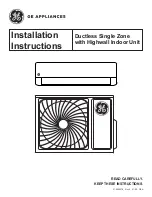
Installation and operation manual
3
FDYMP71~125L7V1
Split System air conditioners
4PW14036-1B
I
NDOOR
UNIT
INSTALLATION
When installing optional accessories read also the installation
manual of the optional accessories. Depending on the field
conditions, it may be easier to install optional accessories before the
indoor unit is installed.
1.
Install the indoor unit temporarily.
•
Attach the hanger bracket to the suspension bolt. Be sure to
fix it securely by using a nut and washer from the upper and
lower sides of the hanger bracket.
(See figure 2)
2.
Check if the unit is horizontally levelled.
•
If the unit is tilted against condensate flow, condensate water
could drip out of the unit.
•
Check if the unit is levelled at all four corners with a water
level or a water-filled vinyl tube as shown in
figure 3
.
3.
Tighten the upper nut.
R
EFRIGERANT
PIPING
WORK
For refrigerant piping of outdoor unit, refer to the installation manual
supplied with the outdoor unit.
■
Use a pipe cutter and flare suitable for the used refrigerant.
■
Apply ether oil or ester oil around the flare portions before
connecting.
■
To prevent dust, moisture or other foreign matter from infiltrating
the tube, either pinch the end, or cover it with tape.
■
The outdoor unit is charged with refrigerant.
■
Be sure to use both a spanner and torque wrench together when
connecting or disconnecting pipes to/from the unit.
■
Refer to
Table 1
for the dimensions of flare nut spaces and the
appropriate tightening torque. (Overtightening may damage the
flare and cause leaks.)
Table 1
■
When connecting the flare nut, coat the flare both inside and
outside with ether oil or ester oil and initially tighten by hand
before tightening firmly.
■
Check the pipe connector for gas leaks, then insulate it.
D
RAIN
PIPING
WORK
1
Install the drain pipes.
-
Keep piping as short as possible and slope it downwards so
that air may not remain trapped inside the pipe.
-
Keep pipe size equal to or greater than that of the connecting
pipe.
-
For connection to the drain socket: use a flexible hose (field
supply) and clamp it firmly. This to avoid leaks due to
operating vibration of the unit.
-
After clamping, isolate the drain socket. This is to avoid leaks
due to sweating of the unit.
-
Do not use a trap in the drain piping.
-
Never put the end of the drain hose into water.
2
Insulate the drain hose inside the building.
3
Drain check
-
Execute the drain check before installing the duct
-
Make sure that the drain hose is firmly connected
-
Pour some water into the drain pan to check if the water flows
smoothly.
1
Nut (field supply)
2
Washer for hanger bracket (field supply)
3
Tighten (double nut)
1
Water level
2
Vinyl tube
NOTE
Required service opening dimensions for air filter
maintenance (See
figure 1
and
figure 4
)
NOTE
All field piping must be provided by a licensed
refrigeration technician and must comply with the
relevant local and national codes.
1
Torque wrench
2
Spanner
3
Piping union
4
Flare nut
W
Width of service opening
D
Depth of service opening
h
Distance unit-false ceiling
Model
W
D
FDYMP71•100
≥
920
If h
≤
30
⇒
D
≥
100
FDYMP125
≥
1320
If h>30
⇒
D
≥
200
2
3
1
4
Pipe
gauge
Tightening torque
Flare
dimension A
(mm)
Flare shape
Ø9.5
32.7~39.9 N•m
(333~407 kgf•cm)
12.0~12.4
Ø15.9
61.8~75.4 N•m
(630~770 kgf•cm)
18.6~19.0
Ø19.1
97.2~118.6 N•m
(990~1210 kgf•cm)
22.9~23.3
Coat here with ether oil
or ester oil
1
Liquid pipe
2
Gas pipe
3
Insulation for fitting of liquid line (field
supply). The insulation should
withstand 80°C.
4
Insulation for fitting of gas line (field
supply). The insulation should
withstand 120°C.
5
Clamps (use 2 clamps per insulation)
1
Metal clamp
2
Flexible hose
3
Insulation
4
Plastic clamp
R=0.4~0.8
45
° ±
2
90
°±
4
A
3
4
1
2
5
1
4
2
3






























